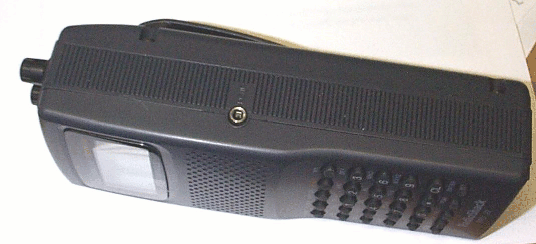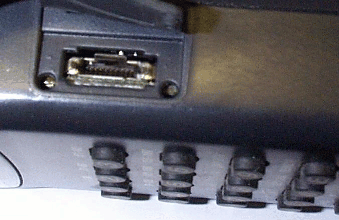Trunk-tracking scanners are designed to be useful and practical right out of the box, but most users don't take advantage of all the features and capabilities provided by the manufacturer. One increasingly common feature is the ability to connect the scanner to a personal computer. This month we'll take a look at basic computer interfacing with a few popular trunk-tracking scanners.
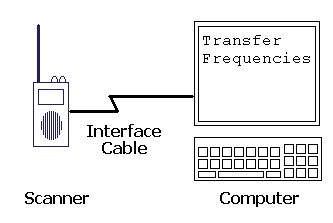 In the simplest form, a computer interface will save you from having to
enter each and every frequency through the keypad. You can put your
favorite frequencies in a text file on the computer, convert it into
a database, and then transfer it to your scanner. If you'd like to
try different bank arrangements or you accidentally lose your scanner
settings, you can easily reload them with just a few keystrokes or clicks
of the mouse.
In the simplest form, a computer interface will save you from having to
enter each and every frequency through the keypad. You can put your
favorite frequencies in a text file on the computer, convert it into
a database, and then transfer it to your scanner. If you'd like to
try different bank arrangements or you accidentally lose your scanner
settings, you can easily reload them with just a few keystrokes or clicks
of the mouse.
In order to take advantage of a computer interface you'll need three things. First, the scanner must have the ability to accept a connection to a computer. A number of scanners come from the factory with a jack or data port already installed. In fact, some radios are controllable only by computer, such as the ICOM PCR-1000 and the Optoelectronics OptoCom. If your radio doesn't have such a connection you may be able to use John Montalbano's PROgramit hardware design to add a remote keypad control. More information about that can be found on John's website at www.qsl.net/ka2pyj/.
If your scanner already has a computer interface capability then there are only two remaining issues: hardware and software. Hardware is usually in the form of a cable between the scanner and the computer. Some scanners come with a computer cable while others require you to purchase or build one. The cable attaches to a serial port on the computer, either a 9-pin or 25-pin "D" shell connector on a PC or a multiple-pin DIN connector on a Macintosh. The 9-pin connector is often referred to as a "DB-9" and the 25-pin version as a "DB-25." Newer computers typically have DB-9 connectors, while older computers and many modems still use DB-25.
Once the proper hardware is in place, all that remains is software. Almost all trunk-tracking scanners that come with computer interfaces have both commercial and non-commercial (either free or low-cost "shareware") programs that exploit the capabilities of the interface. These programs vary in capability from simple command-line frequency transfer utilities to full-blown graphical interfaces for remote operation and control.
The Radio Shack PRO-92 is a handheld trunk-tracking scanner built by GRE that follows Motorola, EDACS and LTR systems. The PRO-92 has a mini-jack labeled "PC/IF" (personal computer interface) on the right side of the radio. The unit comes with a "clone" cable that allows the programming from one PRO-92 to be transferred into another. The cable itself has a 1/8-inch mono phone plug on each end, so an adapter is needed to attach it to the DB-9 or DB-25 connector on a PC.
Technically speaking, the PRO-92 does not allow full computer control. The interface is limited to uploading and downloading memory settings, as well as some radio parameters such as rescan time and backlight duration. Unfortunately, you cannot use the interface to, for instance, tune to a specific frequency or check the current signal strength as you can with some other scanners.
GRE sells a package for the PRO-92 called Scanner Data Manager that includes computer software and a PC interface cable. It works by emulating the clone mode of a second PRO-92 and allows you to transfer frequencies into the scanner from your Windows-based PC. The package is available from Radio Shack on-line at www.radioshack.com or via their 1-800-THE-SHACK number as catalog number 940-1223 and retails for $69.99. Finding an in-store sales clerk that is able to identify and order the proper item seems to vary from store to store. My local Radio Shack store happens to have at least one knowledgeable and experienced sales person, but not every store is so well staffed.
There are also third parties producing PRO-92 cables, which come in two different types. The first is a one-way cable that allows you to download frequencies into the scanner. The other is a two-way cable that will allow both downloading into the scanner and uploading from the scanner. If you're handy with a soldering iron there are several different plans and schematics on the Internet that will instruct you on how to build your own.
Several free programs are available on the Internet that provide the ability to quickly upload and download frequency banks, change the weather (WX) channels to user-selected frequencies and even set the backlight timeout. Versions of these programs run under DOS, Windows, and Linux. The source code for many of these programs is also available.
Radio Shack PRO-93
The Radio Shack PRO-93 is a new handheld scanner built by GRE that follows Motorola and EDACS systems. I've been informed that the interface cables for the PRO-92 also work with the PRO-93 but the software does not. The PRO-93 Owner's Manual indicates that the cloning cable is not supplied but that there is an "optional PC interface kit" that will allow transfer of frequency information to and from a PC.
Uniden BC 245XLT
The Bearcat BC 245XLT is a handheld scanner built by Uniden that follows Motorola and EDACS systems. It's been out for nearly three years now and comes with a full computer control capability.
When the 245XLT was introduced, Uniden decided not to reveal the details regarding the format and meaning of the messages and instructions used by the computer interface, presumably to prevent other companies from writing software for the radio. However, just like the "secret" protocol used by the ICOM PCR-1000, many people managed to work out the messages and instructions by eavesdropping on the serial communication between the scanner and a computer running manufacturer-approved software. This process of "reverse engineering" the protocol resulted in a list of known commands and soon afterward a series of third-party software programs started to appear. As it turns out, the 245XLT uses a protocol very similar to the earlier base station scanner model 895XLT, so many programs will work on both radios.
The 245XLT has a "remote" jack located on the right side of the radio, covered by a rubber flap. The cable that comes with the scanner plugs into this jack and connects to either a personal computer, an external modem or another cable, depending on the kind of connection mode you want.
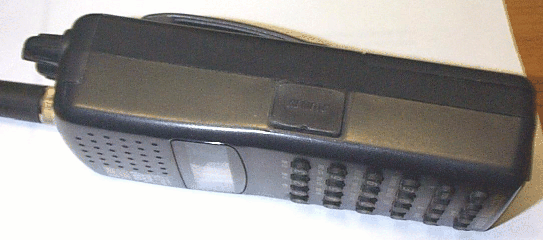
The Smartscan Mode is a way for users to have their scanner frequencies programmed in directly from Uniden. The user connects the scanner to a modem, enters the local ZIP code and has the modem dial a 900 number. Once connected, the modem delivers frequency information to the 245XLT from Uniden's National Frequency Database server.
In order to connect the scanner directly to a modem a small device called a null modem adapter is needed between the modem and the cable. This device rearranges the signals from one side to the other and allows the scanner to communicate properly with the modem. These adapters are available from retail computer and electronics stores.
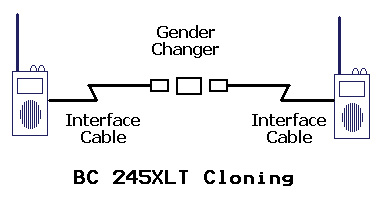 In Clone Mode two 245XLTs are connected together to transfer
frequencies from one to another. This setup will require a null modem
adapter and possibly another device called a gender changer to
allow the cables to mate together properly. The cable that comes with
the scanner is referred to as a female DB-9, meaning the 9 wires end up
as holes at the edge of the connector rather than as pins as they do on
the male DB-9. Since most null modem adapters have a male connector on
one end and a female adapter on the other end, without the gender changer
you'll end up with two female DB-9s and no way to connect them.
In Clone Mode two 245XLTs are connected together to transfer
frequencies from one to another. This setup will require a null modem
adapter and possibly another device called a gender changer to
allow the cables to mate together properly. The cable that comes with
the scanner is referred to as a female DB-9, meaning the 9 wires end up
as holes at the edge of the connector rather than as pins as they do on
the male DB-9. Since most null modem adapters have a male connector on
one end and a female adapter on the other end, without the gender changer
you'll end up with two female DB-9s and no way to connect them.
For the Remote (PC Control) Mode you simply connect the scanner cable straight into an available serial port on the back of the computer. Older PCs may have a 25-pin connector, in which case a 9-to-25-pin adapter from a computer or electronics store will do the trick.
Many commercial software packages support the 245XLT, as you can see from the advertisements here in Monitoring Times. Non-commercial software programs are also available on the Internet.
One interesting application is sharing frequency files. Doug Fisher operates a "scanning files website" at home.earthlink.net/~dougfisher/scanner.html where 245XLT owners can share their frequency lists with others. Using a simple backup utility, the contents of the scanner's frequency banks are copied into a computer file and then uploaded to Doug's website. Other owners can then download the file and transfer it into their scanner. The site currently appears to be focused on various automobile racing frequency sets.
Uniden BC-780XLT
The Bearcat BC-780XLT is a mobile/base trunk-tracking scanner built by Uniden that follows Motorola, EDACS and LTR. The radio has a standard DB-9 connector on the back, so any regular serial cable with the proper connectors should work. The protocol used on the computer interface is very similar to the 245XLT (the protocol differences between the 895XLT, 245XLT and the 780XLT seem to be mostly related to hardware features of the different radios) and there are a number of software programs available from commercial and non-commercial sources.
Besides the usual Windows applications, there is a UNIX software package at freshmeat.net/projects/780xlt-display/ that provides basic radio controls and displays frequency, talkgroup and current signal strength through a simple X-11 graphical interface.
For a more portable interface there are several programs for the Palm Pilot series of Personal Digital Assistants (PDA) that allow remote control of many scanner functions.
A somewhat more unusual application for computer control of the 780XLT is a poor-man's spectrum analyzer. Since a computer can instruct the scanner to tune to a specific frequency and report the signal strength, it is possible to write a software program to quickly tune in small increments from a starting frequency to an ending frequency and plot the signal strength on the computer screen. This gives a graphical representation of the radio activity occurring between the starting and ending frequencies.
Encrypting EDACS
The attacks of September 11, 2001, have given a new argument those agencies that want to prevent scanner listeners from hearing public safety communications, and radio system manufacturers are responding.
M/A-Com, the current provider of EDACS systems, has announced a product called the EDACS Security Key (ESK). This optional system feature encrypts the data messages sent on the control channel, shutting out radios and trunk-tracking scanners that do not have the proper decryption key. Agencies will have to shell out $15,000 for the administrative software and $100 per radio to make use of ESK.
ESK is scheduled to become available this summer for both EDACS and ProVoice systems.
That's all for this month. I welcome your electronic mail about computer interfaces or any other radio topic at dan@signalharbor.com, and as always more information is available on my website at www.signalharbor.com. Until next month, happy monitoring!
